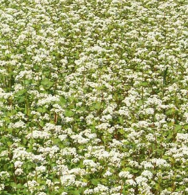
|
Thomas Jefferson and George Washington sang the praises of buckwheat. Today, the broadleaf grain is gaining new popularity as a powerful weed-suppressing cover crop because of its quick establishment and dense growth: In the Northeast, vegetable farmers are rediscovering how to manage buckwheat effectively, thanks to Cornell University research that demonstrated a well-established stand of buckwheat eliminated 98 percent of summer weeds.
The Cornell team, supported by a 2005-08 SARE grant, also developed a definitive, 18-page Buckwheat Cover Crop Handbook that outlines important management strategies. Based on their surveys and outreach, the team estimates that by 2008, their efforts had helped 3,000 farmers use buckwheat successfully on a combined 18,000 acres in vegetable production.
Buckwheat also shows promise in integrated pest management because its prolific flowering attracts beneficial insects. In South Carolina, farmer Daniel Parson is using a 2010 SARE grant to determine whether a buckwheat cover crop can help him control the invasive, highly destructive stink bug.
These projects are only two examples of how SARE is at the forefront of supporting the innovative producers, educators and researchers who are making cover crops one of the most indispensable cost-saving tools in the soil-health toolbox. SARE grantees all over the country are discovering cover crops' dynamic and vital role in managing weeds, diseases and insects. For example:
• University of Hawaii Extension specialists, partnering with local farmers, used three SARE grants to promote farmer adoption of sunn hemp as a cover crop by demonstrating its ability to suppress weeds and parasitic nematodes. They have found sunn hemp also promotes beneficial nematodes and microarthropods that aid in nutrient cycling. They have produced a video and two fact sheets.
• In ongoing research supported by a 2010 SARE grant, University of Illinois researchers are investigating the role cover crops play in suppressing root and foliar diseases in soybeans. Testing a variety of cover crop species, the research team is finding early evidence that rye may aid in disease suppression.
• In a 2008-11 project, University of Maryland Extension specialists helped one nursery farmer save $115 per acre per production cycle by planting a fescue cover crop between rows, which reduced the number of times he had to mow to control weeds. The team's goal was to explore how to better use cover crops in nursery production.
This only scratches the surface of the hundreds of research and on-farm demonstration projects SARE has supported on cover crops in the last 25 years. To discover more, and to find the practical tools and guides, visit SARE's Cover Crops Topic Room.






Post a comment
Report Abusive Comment